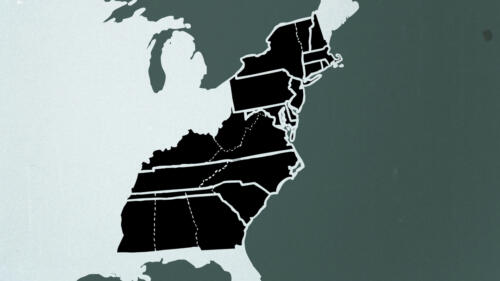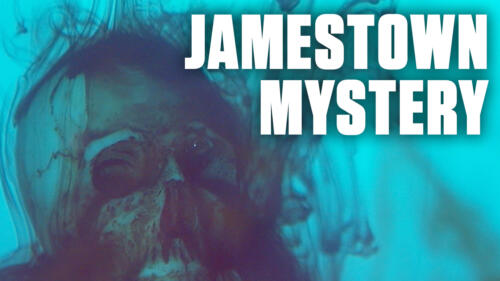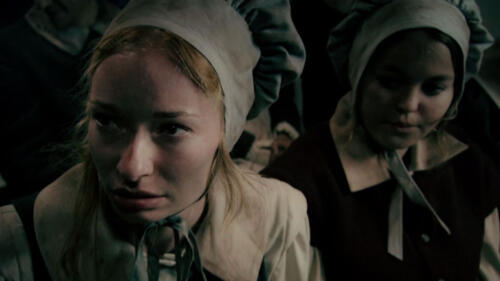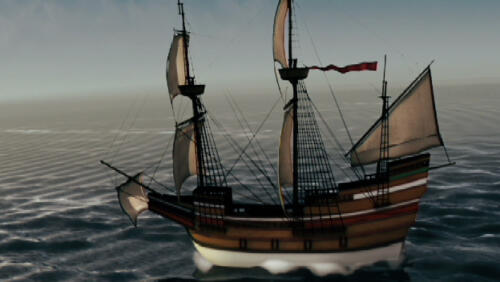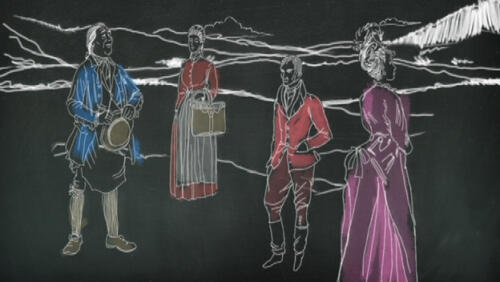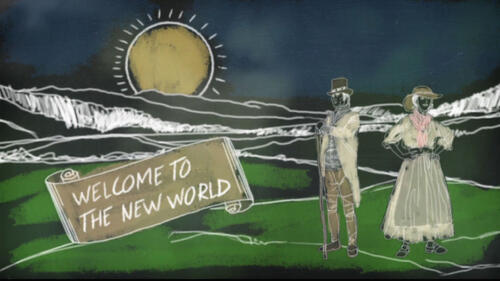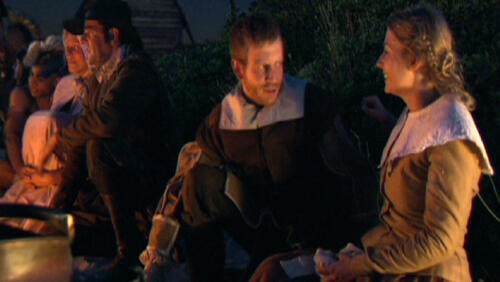Colonial America
Colonial America was a vast land settled by Spanish, Dutch, French and English immigrants who established colonies such as St. Augustine, Jamestown, Roanoke and many others. Often these settlements displaced Native American societies that had preceded them by thousands of years.
Featured Overview
The U.S. is 50 states strong today, but it began as 13 small colonies. Can you name them?
1:34m watch

Hulton Archive/Getty Images
Featured Overview
The U.S. is 50 states strong today, but it began as 13 small colonies. Can you name them?
1:34m watch
Start Here

St. Augustine, Florida was founded by Spanish explorers long before Jamestown and the Plymouth Colony.

They were less religious refugees than economic migrants.

Early American colonists may not have had electricity, plumbing or cars, but they found ways to make daily life easier with these objects.

Kidnapped and taken to Spain, Opechancanough used what he learned of the Europeans to lead his people against two of the world's greatest powers.
Did Jamestown Drink Itself to Death?
Did Jamestown Drink Itself to Death?
Jamestown's demise has been blamed on many causes, from famine and drought, to disease and violence. But was it actually something in the water?
2:44 watch

3 Failed North American Colonies
Explore All Related Topics

Explore five factors that fueled unease and panic over accusations of witchcraft during the Salem witch trials.

John Billington had developed a reputation as a 'knave' among his fellow Plymouth colonists before his notorious conviction.

Before Social Security, American colonists initiated local poverty relief taxes, and differentiations were made between “worthy” and “unworthy” poor.

Standards of education varied widely, and corporal punishment was the norm.

It wasn't just Protestants seeking a place to freely practice their faiths.

From a dancing plague to a laughing epidemic, the symptoms were clear—but the culprit was not.

Kidnapped and taken to Spain, Opechancanough used what he learned of the Europeans to lead his people against two of the world's greatest powers.

The treaty that made the first Thanksgiving possible has a dark backstory.

Those accused lacked basic legal protections, including the premise that one was innocent until proven guilty.

Though adult women—and a few men—accused their neighbors of witchcraft in 1692, the core group of accusers were girls.

The 13 British colonies eventually joined to form the United States—but as colonies, they were often more different than they were alike.

From potted meat to pickles to syllabub, here are some foods and beverages that were popular in colonial America.

Colonial governors needed somewhere to buy their shoes, and also their wigs.

Early American colonists may not have had electricity, plumbing or cars, but they found ways to make daily life easier with these objects.

During their two-month voyage to America, the Mayflower's passengers faced cramped quarters, rough seas, limited food and numbing cold.

They were less religious refugees than economic migrants.

From pagan fertility rituals to hallucinogenic herbs, the story of witches and brooms is a wild ride.

St. Augustine, Florida was founded by Spanish explorers long before Jamestown and the Plymouth Colony.

Stripped of their most basic human rights, patients nonetheless built lives and communities.

From rum to cakes to rowdy parades, election day was a time for gathering and celebration.

Rather than bathing, early American colonists believed that other practices, like regularly changing their undergarments, qualified as good hygiene.

As families lost one loved one after another in the 19th century, some believed the undead were preying upon them.
We love apples! And in the colonial era, we loved them so much, we used hard apple cider as payment.
1:02m watch

Explore surprising facts about America’s first permanent English settlement.

Pilgrims had to find a way to get along with "strangers" on their ship once they landed in the New World.

Bacon's Rebellion was triggered when a grab for Native American lands was denied.

Both sought a different religious practice than what the Church of England dictated, but they were otherwise distinct groups of people.
Jamestown's demise has been blamed on many causes, from famine and drought, to disease and violence. But was it actually something in the water?
2:44m watch

Seeking: Hardy women to marry into Colonial America's first settlement.

There’s evidence that British colonists in 18th-century America gave Native Americans smallpox-infected blankets at least once—but did it work?

It all started with a fight with carpenters working on her house.
Trapped, scared, and starving, the first permanent settlers in the New World were forced to resort to a horrific means of survival.
3:27m watch

Lotteries helped build libraries, roads and even Harvard.

An elderly widow, a beggar and a church-going woman who made a stand against the trials were among those executed.
Giles Corey was accused of witchcraft and crushed to death by the sheriff of Salem. With his dying words, he cursed both the sheriff and the town.
3:13m watch

Life in the early 1600s at Jamestown consisted mainly of danger, hardship, disease and death.

Tituba has become a legend—but she was all too easy to scapegoat

The Catholic and Protestant churches promoted themselves by persecuting witches, economists argue.

Much has been forgotten about the infamous mass hysteria.

Meet the man who recreates colonial recipes.

For nearly 20 years in the 17th century, Sweden had a little-known colony that spanned parts of Delaware, Pennsylvania and New Jersey.

An original, extremely rare document from one of the Salem witch trials in 1692 went up for auction at Christie’s in New York

Many of the details of the Popham colony have been lost to history, but in its heyday the tiny settlement in Maine was considered a direct rival of Jamestown.

These six trials were part of the worldwide witch hunt frenzy.
The U.S. is 50 states strong today, but it began as 13 small colonies. Can you name them?
1:34m watch

Check out eight of the world’s most notable time capsules.

Ongoing excavations at two sites in North Carolina have yielded new clues about what may have happened to the English settlers who vanished from Roanoke Island around 1590.

Today we may know them simply as Texans, but deciding what to call the people living in Texas in the pre-Texas Revolution era was a matter of some confusion. According to an issue of the Telegraph and Texas Register published on November 7, 1835, various people used the terms Texans, Texonians, Texasians and Texicans, but: […]

History is full of bizarre, seemingly impossible coincidences. Check out six stories that may sound unbelievable—but are all true.

When Mexican troops stormed the former mission known as the Alamo on the morning of March 6, 1836, Mexican General Antonio López de Santa Anna ordered that no prisoners be taken. Did anyone at the Alamo survive? Santa Anna’s Mexican army killed virtually all of the roughly 200 Texans (or Texians) defending the Alamo, including […]

After more than two months at sea, the Pilgrims aboard the storm-tossed Mayflower finally spied the New England coastline as dawn broke on November 9, 1620. Although William Bradford reported that the Pilgrims were full of joy after enduring a “long beating at sea,” his fellow passengers also knew that the Atlantic Ocean’s fierce storms […]

From Humphrey Bogart to Julia Child, find out about seven famous Americans whose relatives came over on the Mayflower.

Get the facts on the only Dutch colony in mainland North America, which included present-day New York City.

In January 1692, a group of young girls in Salem Village, Massachusetts became consumed by disturbing “fits” accompanied by seizures, violent contortions and bloodcurdling screams. A doctor diagnosed the children as being victims of black magic, and over the next several months, allegations of witchcraft spread like a virus through the small Puritan settlement. Twenty […]

From barbaric tortures and occult dessert dishes to unwinnable trials by ordeal, find out more about seven unusual tests once used as evidence of supernatural misconduct.

Explore the real history of the Pilgrims' purported landing place—Plymouth Rock.

Discover five things about the hosts of the first Thanksgiving that might come as a surprise.

Find out about the accusations and trials that rattled Hartford, Connecticut, in 1662.
Rampant fear among the Puritans in the New England village of Salem sparked attacks against anyone who was suspected of witchcraft.
2:55m watch

How could 115 people just vanish?
How many people were on the Mayflower? And how long did it take for them to get to Plymouth? Get the facts.
2:35m watch
English settlers arrived at Jamestown expecting riches to fall into their hands, but were soon faced with a much harsher reality.
1:07m watch
Before Jamestown and Plymouth, the English attempted to forge a colony at Roanoke. Within three years, it had disappeared, leaving a mysterious clue behind. What really happened to the Roanoke settlers?
1:56m watch
Find out what it took to be a settler in the early-American colony of Jamestown.
2:45m watch

The infamous Salem witch trials were a series of prosecutions for witchcraft starting in 1692 in Salem Village, Massachusetts. Learn about what led to the allegations and the hundreds of people who were were accused.

Geologists are investigating whether tainted drinking water killed most of Jamestown’s colonists during the “starving time” of 1609-1610.

The 13 Colonies were a group of colonies of Great Britain that settled on the Atlantic coast of America in the 17th and 18th centuries. The colonies declared independence in 1776 to found the United States of America.

The Jamestown Colony was the first permanent English settlement in North America. It was founded on the banks of Virginia's James River in 1607.

The Mayflower was a merchant ship that carried 102 passengers, including nearly 40 Protestant Separatists, on a journey from England to the New World in 1620.

Plymouth Colony was a British colony in Massachusetts settled by travelers arriving on the Mayflower in the 17th century. It was the first colonial settlement in New England and was the site of the first Thanksgiving.

The Pilgrims were the people who arrived in Massachusetts via the Mayflower in 1620 and formed the first permanent settlement of Europeans in New England.

John Smith helped establish Jamestown, the first permanent English colony in North America. Smith was allegedly saved from death by Native American woman Pocahontas.

Anne Hutchinson was a popular Puritan preacher in colonial New England. She was banished from Massachusetts for preaching ideas that church leaders found heretical.

Roger Williams (1603-1683) was a political and religious leader who settled the state of Rhode Island in 1636 and advocated for the separation of church and state in Colonial America.

The Puritans were members of a religious reform movement that arose in the late 16th century and held that the Church of England should eliminate ceremonies and practices not rooted in the Bible.

The Mayflower Compact was a set of rules for self-governance established by the English settlers who traveled to the New World on the Mayflower.

William Bradford was an English Puritan separatist who sailed to North America aboard the Mayflower in 1620. He served as governor of Plymouth Colony for more than 30 years, chronicling his experiences in a journal that became the authoritative account of the Pilgrims and Plymouth Colony.
